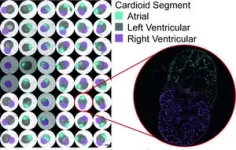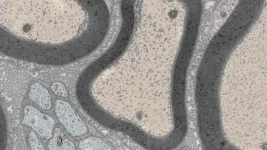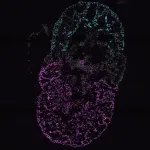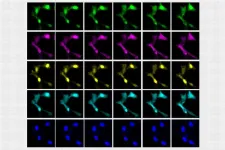(Press-News.org) (MEMPHIS, Tenn. – November 28, 2023) Scientists at St. Jude Children’s Research Hospital comprehensively identified genes directly regulated by a protein associated with high-risk pediatric leukemias. High-risk leukemias, particularly MLL-rearranged (MLL-r) leukemia, often overexpress the homeodomain transcription factor HOXA9 protein, which cannot currently be targeted with drugs. This study provides a foundation for revealing the HOXA9 regulation network and finding novel drug targets downstream of HOXA9 that can form the basis of new treatments. The findings were published today in Nature Communications.
HOXA9 is a transcription factor, a type of protein that binds DNA to regulate the expression of other genes. Overexpression of HOXA9 is a hallmark in many cancers, including high-risk leukemias, such as the MLL-r subtype. Finding the genes regulated by HOXA9 could reveal new ways to treat leukemia by undermining how the protein helps cancers grow and survive.
Due to the technical challenges of working with HOXA9, the downstream regulation network of the protein was poorly understood. The St. Jude team established a unique system to find these genes regulated by HOXA9.
“We confirmed two major known targets, FLT3 and CDK6,” said corresponding author Chunliang Li, Ph.D., St. Jude Department of Tumor Cell Biology. “Both genes can be therapeutically targeted by drugs, which shows good outcomes in preclinical models with HOXA9 overexpression. Our results provided direct evidence to support the enhancer regulation of FLT3 and CDK6 through HOXA9.”
In addition to these well-studied genes, the scientists found 227 other target sites bound by HOXA9. Many of those sites were located at noncoding regulatory regions, likely enhancers. They validated the top 10 candidates in cell-based experiments conducted in collaboration with computational biologists from the St. Jude Center for Applied Bioinformatics. Several of these hits explained previous results observed using current Food and Drug Administration-approved drugs, which lends credibility to the other results from the screen and suggests they may be productive targets for novel leukemia drugs.
To perform the screen, the St. Jude group established a TetOn-inducible system to express tagged HOXA9 in MLL-r leukemia cell lines. Using this unique research tool followed with chromatin immunoprecipitation sequencing (ChIP-seq) technology, they successfully identified where in the genome HOXA9 binds DNA in MLL-r leukemic cells.
“Using state-of-the-art research tools and elegant model systems, we have a better understanding of how HOXA9 works in high-risk leukemia cells,” said co-first author Shaela Fields, St. Jude Department of Tumor Cell Biology. “Now, we can start the long process to find and develop new drugs to make our patients healthier by taking advantage of that information.”
Overcoming a HOXA9 family problem
While it was previously known that HOXA9 is overexpressed in high-risk pediatric leukemias, it has historically been challenging to study and target. The HOX family of proteins contains 39 members, which are all very similar to each other. The similarity also makes it challenging to study because current techniques have trouble distinguishing between the HOX proteins. Functionally, other HOX family members could potentially compensate for HOXA9 function upon targeting.
With that in mind, the researchers created a system that identified the genes bound specifically by HOXA9 in a certain leukemia subtype (mixed-lineage leukemia rearrangement or MLL-r) by inserting a tag onto HOXA9.
“Imagine you are in a dog park and need to find a certain golden retriever, but there are a bunch of them running around, and you don't know which one is yours because all the dogs look the same,” said Li. “If you put a neon pink harness on your dog beforehand, it’s easy to find among the group. That is how we could track everywhere HOXA9 went.”
The small tag does not affect HOXA9's regular function and makes HOXA9 easy to trace in cells. The researchers then sequenced the attached DNA to identify the leukemia-related genes bound by HOXA9, allowing scientists to study this relatively small list of genes that may be amenable to therapeutic development.
“We narrowed hundreds of thousands of targets to just over two hundred by comparing to controls,” said Fields. “And when we can investigate the regulation mechanism and network of HOXA9, and what’s happening in the cells, that’s where hopefully we can find ways to help kids with high-risk cancers get better.”
Authors and funding
The study’s other co-first author is Xujie Zhao, formerly of St. Jude. The study’s other authors are Wojciech Rosikiewicz, Judith Hyle, Wenjie Qi, Zhenling Liu, Siqi Yi, Yong Cheng and Beisi Xu, all of St. Jude; and Shelby Mryncza, Rhodes College.
The study was supported by grants from the National Cancer Institute (5P30CA021765), American Cancer Society (RSG-476 23-874240-01-DMC), V-Foundation (V2021-010) and ALSAC, the fundraising and awareness organization of St. Jude.
St. Jude Media Relations Contacts
Chelsea Bryant
Desk: (901) 595-0564
chelsea.bryant@stjude.org
media@stjude.org
Rae Lyn Rushing
Cell: (901) 686-2597
raelyn.rushing@stjude.org
media@stjude.org
St. Jude Children's Research Hospital
St. Jude Children's Research Hospital is leading the way the world understands, treats and cures childhood cancer, sickle cell disease and other life-threatening disorders. It is the only National Cancer Institute-designated Comprehensive Cancer Center devoted solely to children. Treatments developed at St. Jude have helped push the overall childhood cancer survival rate from 20% to 80% since the hospital opened more than 60 years ago. St. Jude shares the breakthroughs it makes to help doctors and researchers at local hospitals and cancer centers around the world improve the quality of treatment and care for even more children. To learn more, visit stjude.org, read St. Jude Progress blog, and follow St. Jude on social media at @stjuderesearch.
END
St. Jude revealed functional targets of oncogenic HOXA9 in high-risk pediatric leukemia
2023-11-28
ELSE PRESS RELEASES FROM THIS DATE:
Human rights are a low priority for many national climate change adaptation policies, new Concordia research finds
2023-11-28
The link between human rights and climate change adaptation policy has not been a major source of discussion in national policies, according to a new Concordia-led study. Moreover, the researchers say the topic should play a bigger role in the upcoming COP28 conference, opening this week in Dubai.
The paper was published in the journal Climate Policy. Assistant professor in Concordia’s Department of Geography, Planning and Environment Alexandra Lesnikowski co-authored the study with researchers from McGill University’s Faculty ...
Want school kids to eat more vegetables? Don’t forget about the power of potatoes on the plate
2023-11-28
A new study published in Nutrients illustrates how potatoes may play a beneficial role in encouraging school aged children to eat more vegetables. The Dietary Guidelines for Americans currently recommends children ages 3-18 consume between 2.5-3 cups of vegetables per day to meet their total vegetable goals. Yet, the average school-age child eats only about 1 cup daily. “That’s why we wanted to learn more about how school meal offerings may influence kids’ eating behavior and possibly encourage greater vegetable consumption,” explains principal ...
Repairing nerve cells after injury and in chronic disease
2023-11-28
LA JOLLA (November 28, 2023)—Each year in the United States there are more than 3 million cases of peripheral neuropathy, wherein nerves outside of the brain and spinal cord are damaged and cause pain and loss of feeling in the affected areas. Peripheral neuropathy can occur from diabetes, injury, genetically inherited disease, infection, and more. Salk scientists have now uncovered in mice a mechanism for repairing damaged nerves during peripheral neuropathy. They discovered that the protein Mitf helps turn on the repair function of specialized nervous system Schwann cells.
The findings, published in Cell Reports ...
First multi-chamber heart organoids unravel human heart development and disease
2023-11-28
Heart disease kills 18 million people each year, but the development of new therapies faces a bottleneck: no physiological model of the entire human heart exists – so far. A new multi-chamber organoid that mirrors the heart’s intricate structure enables scientists to advance screening platforms for drug development, toxicology studies, and understanding heart development. The new findings, using heart organoid models developed by Sasha Mendjan’s group at the Institute of Molecular ...
Race and ethnicity and emergency department discharge against medical advice
2023-11-28
About The Study: The findings of this study of 33.1 million visits to 989 U.S. hospitals suggest that Black and Hispanic patients are more likely to receive care in hospitals with higher overall discharge against medical advice (DAMA) rates, suggesting interventions should address medical segregation. Structural racism may contribute to emergency department DAMA disparities via unequal allocation of health care resources in hospitals that disproportionately treat racial and ethnic minoritized groups. Monitoring variation in DAMA by race and ethnicity and hospital suggests ...
Strategies to increase cervical cancer screening with mailed HPV self-sampling kits
2023-11-28
About The Study: Direct-mail human papillomavirus (HPV) self-sampling increased cervical cancer screening by more than 14% in individuals who were due or overdue for cervical cancer screening in this randomized clinical trial of 31,000 individuals. The opt-in approach minimally increased screening. To increase screening adherence, systems implementing HPV self-sampling should prioritize direct-mail outreach for individuals who are due or overdue for screening. For individuals with unknown screening history, ...
Scientists track rapid retreat of Antarctic glacier
2023-11-28
Scientists are warning that apparently stable glaciers in the Antarctic can “switch very rapidly” and lose large quantities of ice as a result of warmer oceans.
Their finding comes after a research team led by Benjamin Wallis, a glaciologist at the University of Leeds, used satellites to track the Cadman Glacier, which drains into Beascochea Bay, on the west Antarctic peninsula.
Between November 2018 and May 2021, the glacier retreated eight kilometres as the ice shelf at the end ...
A new way to see the activity inside a living cell
2023-11-28
CAMBRIDGE, MA -- Living cells are bombarded with many kinds of incoming molecular signal that influence their behavior. Being able to measure those signals and how cells respond to them through downstream molecular signaling networks could help scientists learn much more about how cells work, including what happens as they age or become diseased.
Right now, this kind of comprehensive study is not possible because current techniques for imaging cells are limited to just a handful of different molecule types within a cell at one time. However, MIT researchers have developed ...
Prioritizing circulation before the airway in trauma may improve outcomes for patients with massive bleeding
2023-11-28
Key takeaways
· A paradigm shift in trauma care: The circulation-airway-breathing (CAB) sequence has gained acceptance over the past decade over the airway-breathing-circulation (ABC) model for patients with severe bleeding injuries.
· Better outcomes: A literature review found significantly lower mortality rates with CAB vs. ABC for patients with severe bleeding injuries.
CHICAGO (November 28, 2023): For trauma patients suffering from massive blood loss, a care approach that emphasizes halting bleeding and restoring ...
Australian patients coping with mesothelioma experienced higher levels of toxicity on CheckMate743 regimen than reported in clinical trials
2023-11-28
Based on results from the CheckMate743 trial, the dual regimen of ipilimumab and nivolumab is the standard of care for the treatment of unresectable pleural mesothelioma. But research published today in the Journal of Thoracic Oncology (JTO) showed that a group of Australian patients treated with that immunotherapy combination experienced higher levels of toxicity than were reported in the clinical trial results. The study is available here: https://www.jto.org/article/S1556-0864(23)02370-5/fulltext.
JTO is the official journal of the International Association for the Study of Lung Cancer.
Australia ...








